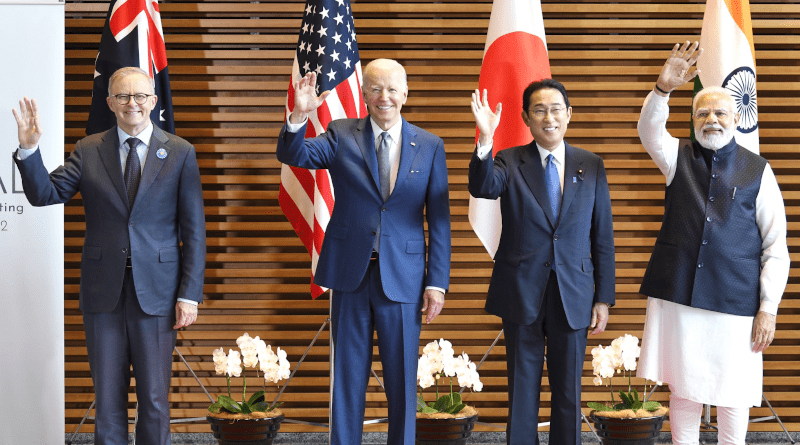Geopolitics Of Eurasia And Indo-Pacific Region: US Quad Summit In Japan – OpEd
By Patial RC
President Biden with the Quad summit at this uncanny timing while still remaining focused dealing with the Ukraine crisis wanted to convey to the world loud and clear,that US is capable to remain focused in the Geopolitics of Eurasia and Indo-Pacific region. Russian aggression against Ukraine has reshaped the world order with re-groupings. The Chinese virtual influence in the world appears to have however,been over hyped by the media without having any real direct involvement in the Russia Ukraine conflict.
The Russia Ukraine conflict had also given an impression that US has put the Indo-Pacific region security concerns on a back burner.So the aim of the Quad Summit in Japan in the so called Chinese backwaters was to deliver a message to President Xi Jinping that to counter China challenges in the South China Sea and Indo-Pacific region remains a priority to be dealt with like minded nations through the Quad. Biden recently warned China that “US would intervene militarily to protect the island (Taiwan) if it is attacked”.
The China factor once again has been a catalyst in bringing the four Quad nations on a common platform in Japan. With the bilateral relations with Beijing strained during recent years, these countries are keen to find multilateral frameworks to meet the China challenge. These include the China’s Belt and Road Initiative (BRI) capabilities across the world.The Quad agenda has been evolving and the ambitions of the four nations now include key areas of convergence like trade, infrastructure, maritime security, health, climate change and emerging technologies.The Quad’s ambitions and visibility have only increased over the past few years and especially after Joe Biden became the president.
Beijing Reactions:
- Beijing’s initial reaction to the Quad was to dismiss it, saying the group would “dissipate like sea foam”. But it later sharpened its criticism of the group, calling it the “Asian Nato”.
- “Sinister Gang of Indo-Pacific to contain China.” Global Times called Quad after its first summit in Washington September 2021.
- “The cooked up Indo-Pacific strategy is bound to fail as it is vigorously promoted by Washington to contain Beijing.” -Chinese foreign minister Wang Yi.
- Washington accusations on China include “the militarization of disputed features, the dangerous use of coast guard vessels and maritime militia, and efforts to disrupt other countries’ offshore resource exploitation activities.”
- Tokyo summit also came up with a so-called Indo-Pacific Partnership for Maritime Domain Awareness, claiming to focus on combating illegal fishing – China’s “illegal fishing” to provoke relations between China and Asia-Pacific countries .
- The Indo-Pacific Economic Framework (IPEF) that the US launched has roped in 12 founding member countries besides the US itself. How many Asia-Pacific countries are willing to confront China on security and decouple from China on economy?
- Washington claims that it “does not seek confrontation with China,” but it has perfected its ability to say one thing but do another.
The war in Ukraine is one such example where India stands apart from the other three nations in its response. Indian constraints and its stands is better understood and appreciated now and is critical to the success of the Quad. India’s role against Chinese expansionism is central to the evolving geopolitical order in the region.The 2+2 Dialogue – attended by the foreign and defence ministers of the US and India have helped smooth the differences over Ukraine.
Indo-Pacific Economic Framework (IPEF)
Indo-Pacific Economic Framework (IPEF) is a great idea which will provide the Quad members a platform for economic negotiations . However,many IPEF members have trade ties with China despite security concerns. China in the near future will remain a part of the the existing economic system. Countering China’s deep multilateral trade ties will be a major challenge to all towards the ultimate success of the IPEF .The success of the Quad will be seen to what extent each Quad member will go to reduce the economic trade inter-dependency on China, which is very large for all.
There is a strong presence of US expatriates in Shanghai, China’s financial headquarters. In 2019, the US’ exports to China reportedly totaled $106.4 billion and the goods imported totaled $451.7 billion. Economic and strategic competition between the US and China is forcing Gulf nations to choose between the two. UAE’s top trading partners are China, India, Japan, the US and Saudi Arabia. UAE is now a member of the ‘Middle Eastern Quad’ (US, Israel, UAE, and India) or Quad 2.
The Quad is not a formal alliance. It is a response to an institutional void in the vast maritime geography of the Indo-Pacific. It is a loose coalition of like-minded countries that are willing to work together on an issue-based agenda. The real issue will be the internal cohesion and long-term commitment of Quad members to make it succeed.However, the security dimension of the Quad needs to be added. The US Quad Summit in Japan was also to tell the world that American hegemony over the world is far from over which China was thinking that it has pushed back the US prior to to the Russian invasion of Ukraine only time will tell who rules the world.
Mackinder’s ‘Heartland Theory’ appears to be somewhat coming true in the form of Russia Ukraine War:
“He who Rules Eastern Europe Rules the Heartland.He who Rules the Heartland Rules the World Island (Europe&Asia) and He who Rules the World Island Rules the world.”

